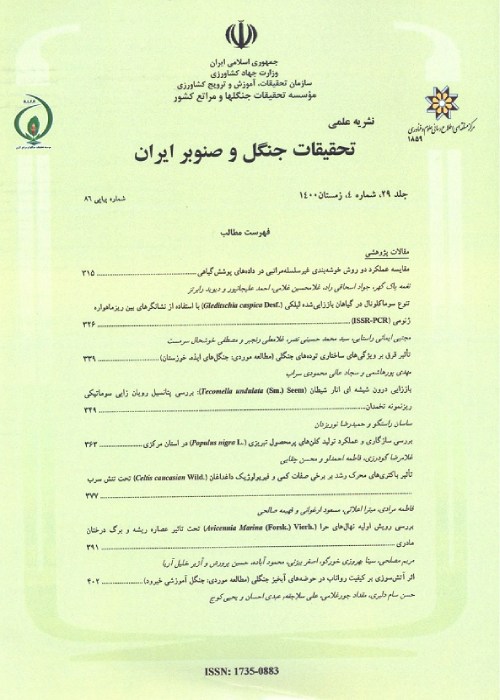Evaluation of the capability of IRS- LISS III and SPOT- HRG data for identification and separation of pollarding forest areas in Northern Zagros (Case Study: Kurdistan, pollarded forests of Baneh)
Author(s):
A. Moradi* , J. Oladi , A. Fallah , P. Fatehi
Abstract:
To evaluate the capability of SPOT5 HRG and IRS-P6 LISS-III in separating the pollarding areas of northern Zagros forests and preparing the map of this area, some parts of pollarded forests located at Baneh city were selected. The pollarding areas (Shan, Kurpe, Khert and Koor) were determined as ground truth in a 3 year alternation period using a global positioning system (GPS). Assessing the radiometric quality, no radiometric error was observed in these data. SPOT5 data which had been already geometrically corrected was used as basis for geometric correction of IRS-P6 color image and IRS-1C panchromatic image. Nonparametric method was used to do geometric correction with Root Mean Square Error (RMSE) of 0.54 and 0.75 pixels for these tow images, respectively. Principal component analysis (PCA) and various spectral rationing methods were used to prepare artificial bands used in data analysis. Likewise, for more image enhancement, HRG and LISS-III multi-spectral bands were fused with IRS-1C pan image. The data was classified using a maximum likelihood (ML) algorithm. This classification was applied using 4 and 6 classes for the studying area and a classification with 3 classes was used for each northern and southern aspects. The separability of classes was studied using Bhuttacharrya Distance Criteria. Result showed that separability of different classes of northern aspect was better than southern aspect. Likewise, northern Khert and agriculture classes were completely separated from other classes. The vegetation indices showed lower results compare to the original bands. Fused bands of SPOT 5 images showed the highest overall accuracy is equal to 65.3% and the highest Kappa coefficient is equal to 0.63. The highest overall accuracy (70%) and Kappa coefficient (0.60) was obtained using the first component analysis resulted from PCA in combination to bands 1 and 4 IRS-P6 data. According to the results of classifying of these two images, the data obtained before pollarding and during of vegetation growth season, showed better results. Regardless of spectral interference between soil and trees crown cover, the results showed the high capability of above mentioned images to separate the pollarding areas and to prepare the map of the area.
Keywords:
Language:
Persian
Published:
Iranian Journal of Forest and Poplar Research, Volume:17 Issue: 3, 2010
Page:
450
magiran.com/p708777
دانلود و مطالعه متن این مقاله با یکی از روشهای زیر امکان پذیر است:
اشتراک شخصی
با عضویت و پرداخت آنلاین حق اشتراک یکساله به مبلغ 1,390,000ريال میتوانید 70 عنوان مطلب دانلود کنید!
اشتراک سازمانی
به کتابخانه دانشگاه یا محل کار خود پیشنهاد کنید تا اشتراک سازمانی این پایگاه را برای دسترسی نامحدود همه کاربران به متن مطالب تهیه نمایند!
توجه!
- حق عضویت دریافتی صرف حمایت از نشریات عضو و نگهداری، تکمیل و توسعه مگیران میشود.
- پرداخت حق اشتراک و دانلود مقالات اجازه بازنشر آن در سایر رسانههای چاپی و دیجیتال را به کاربر نمیدهد.
دسترسی سراسری کاربران دانشگاه پیام نور!
اعضای هیئت علمی و دانشجویان دانشگاه پیام نور در سراسر کشور، در صورت ثبت نام با ایمیل دانشگاهی، تا پایان فروردین ماه 1403 به مقالات سایت دسترسی خواهند داشت!
In order to view content subscription is required
Personal subscription
Subscribe magiran.com for 70 € euros via PayPal and download 70 articles during a year.
Organization subscription
Please contact us to subscribe your university or library for unlimited access!


